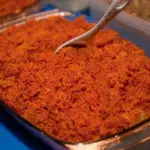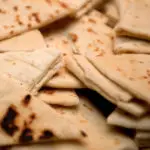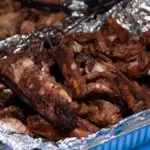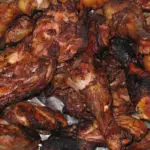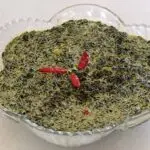Guam's Fiesta Table
Table of Contents
Share This
Melting pot? Look at the table!
Hints of the various cultures of peoples who have made Guam their home can be seen in every aspect of life on Guam. The influences of ethnic diversity are seen in architecture, language, religion and are also evident in the cuisine found in restaurants, homes, and on the fiesta table of today.
The “Guampedia Fiesta Table Project” showcases the diversity of Guam’s community. Locally-produced vignettes showing step-by-step dish preparation are also featured as part of this project. (Click to view videos)
While some dishes originated in the Mariana Islands, some dishes’ origins can be traced back to various places from throughout the world – the Pacific, Europe, Asia, and North and South America. Guam’s native people, however, have a great knack for “Chamorroizing” things, including food, making them uniquely their own. People brought different plants and knowledge of food preparation to the island but their recipes were adapted to what was available locally and to Chamorro tastes. Eventually, through the decades, the dishes met the approval of local palates and were incorporated onto fiesta tables as “local” dishes.
The introduced recipes were passed on to generations of Chamorro families, each including their own special and sometimes secret ingredients. Some of these popular dishes are titiyas, bread, potato salad, tamales, and latiya.
Guam Fiestas
The Mariana Islands, of which Guam is the largest, is home to a large Catholic community. Village parishes hold fiestas to honor their patron saints. As in many places around the world, food is part of the celebration. On Guam, food is a largely important part of festivities as families take pride in the preparation, presentation and in the large variety of dishes on the table offered to guests, which can range in number from as small as twenty to as large as a few hundred.
It is at the fiesta where one will see the manifestation of Guam’s epicurean multiculturalism. The buffet-style spread features cuisine or adaptations of dishes from Spain, America, Mexico, Philippines, China, Japan, and Korea. These sit beside dishes that are common to Pacific islands such as gollai åppan suni, gollai åppan lemmai, gollai åppan aga’, guihan and pång’lao.
Values passed on in food preparation
For some families, a fiesta involves weeks of preparation. The night before is a flurry of activity as everyone prepares for the next day – whether the fiesta is held on a Saturday or Sunday – to welcome guests into their homes. Ingredients, spices and vegetables, and the all-important kitchen areas are readied for dishes of seafood, meats, starches, appetizers, and dessert.
Each family member has roles and duties to fulfill. Girls generally help mothers, aunts, sisters and female cousins with the kitchen duties such as food preparation or area decoration. Boys are with fathers, uncles, brothers, and male cousins helping with the preparation of foods for outside cooking and area preparation such as erecting a påla påla (canopy), setting up chairs, preparing the barbecue, and drinks serving areas.
These activities help children to learn and understand their roles for this important event that celebrates their Catholic religion and the Chamorro value of inafa’maolek: family togetherness, cooperation and interdependence. Young men know how to calculate the amount of meats needed, how to prepare locations for large gatherings, and young women know the ever so important rules of setting the tables and food item designation. Additionally, fiestas show children the importance of being yo’ase’ (hospitable or giving) to family and guests alike. This value is also very important in Chamorro culture; a culture of reciprocation.
What goes where?
Once the food is prepared for presentation, there is a deliberate method of dish placement on the table or tables as dozens of dishes may have been prepared or brought by guests, which is customary. The table is divided into six sections with dishes placed in appropriate locations.
Table sections
- Starch (Åggon) section
- Chicken and Meats (Totche) section
- Fish (seafood) section
- Kelaguen section
- Vegetable and Salad section, and Soup (Kådu) section
- Dessert section, which is commonly placed on a separate table
Table order
Cutlery and napkins are placed at the head of the table. Immediately after are starches or åggon. The most important dish on the table is red rice or hineksa aga’ga’. It is rare to see a fiesta table blessed and opened if the rice has not yet been placed as the first dish of the table. After starches come the totche dishes, which are chicken, beef and pork in this order. A spicy condiment called fina’denne’, which may be spooned over food or used as a dipping sauce, is placed at the end of this section. Seafood dishes are also generally in this section accompanied by the appropriate version of fina’denne’. The appetizer section is next and holds varieties of kelaguen consisting of dishes prepared with lemon, salt and red peppers, similar to the Mexican cerviche.
If there are dishes that are not considered part of the “traditional” fiesta table (and this is becoming increasingly common with the continual introduction of new cuisines on Guam), this takes some skill on the part of the table setter. There may be variations based on the personal preferences of the table setter, but the rule is to place these dishes according to where they best fit within the six sections.
For the most part, dishes like lumpia, pancit and shrimp patties (which could be considered appetizers) are placed after the meats. Although they contain both meat (or protein) and vegetables, they are thought more of as “meat” dishes, so they are placed within the meat section, before the seafood and kinelaguen (dishes prepared in the kelaguen method) and vegetable dishes. The salads are placed towards the end of the table: potato, garden, cucumber, cucumber/diago kimchee and coleslaw. Dishes classified as desserts are at the end of the table.
For larger parties, however, requiring the use of more than one table, uncut meat items such as roasted pig, steamboat roast and ham are set on another table, a carving station, along with relative condiments which includes another bowl of fina’denne. The seafood, kinelaguen and salads may also sit on a separate table, and desserts can also be placed on another table as well.
Placement stems from tradition
For those who know the rules of setting out the food, it is done with ease as this is the way they were taught. Although they may not be aware of why certain dishes go where they do, Chamorros know this is the way it is supposed to be done. If a table is set properly, anyone who is familiar with the settings can navigate easily through the array of dishes.
Chamorro cultural and language expert, University of Guam Professor Rosa Salas Palomo explains that foods in the åggon section: rice, starches and banana cooked in coconut milk prepared in the gollai åppan cooking method are placed at the head of the table, and can be considered the most important of the dishes, because they provide adequate sustenance alone. Also if one looks at the dish placement it shows, in some respects, the chronological introduction and acceptance of foods to the islands, with the exception of seafood dishes.
Grilled or Guam-style barbecue items: chicken, beef, pork and fish are placed after the starches. This section is called totche’, which means to dip or submerge ,and are usually eaten with the traditional dipping sauce called fina’denne’. Seafood dishes are placed after the chicken and meats, which are followed by the kelaguen dishes. Kelaguen dishes are grouped together because of the similar preparation method which uses lemon as a base. Grilled eggplant prepared in coconut milk and lemon is also placed in this area. As for dishes introduced in recent decades, they are placed according to the explanation provided earlier, which is to decide where they belong within the sections. This decision is made by judging the ingredients used in the dish.
While large meat items, such as the steamboat round roast, roasted pig and ham, are placed on a separate table, they were not common fiesta dishes in the not very distant past. It is possible that because of the expense of beef and pork these dishes were reserved for special occasions such as a wedding or baptismal party. Although still costly, the ease of availability has played a factor in their appearance on fiesta tables. Also, though not commonly seen anymore, soups (kådu siha) were also part of the fiesta table because these dishes yielded great quantities to feed the masses of family members and guests. Now, kådu is reserved for family get-togethers, rosaries and “back kitchen” gatherings.
Continuity of culture
The modern fiesta table continues to evolve with the introduction of new dishes, but the main foods remain as well, showing a continuity of culture. The table, which is so important to the fiesta celebration, is a multicultural display of Guam as a melting pot.
Guests arrive with empty stomachs and possibly in awe of the host family’s pride and efforts to put out an array of mouth-watering dishes and decorations in celebration of their faith. Guests leave with full bellies and may not be empty-handed as well, as their hosts encourage them to take food, or balutan– to “wrap” food to take home, as a sign of hospitality and their appreciation for attending their fiesta.
Fiesta Food Entries
- Hineksa’ Aga’ga’: Red Rice
- Pan: Dinner Rolls
- Titiyas: Flatbread
- Gollai Åppan: Starchy Vegetables in Reduced Coconut Cream
- Tamales Gisu: Red and White Tamales
- Barbecue
- Tinala’ Katne: Dried Beef
- Fritada: Pork, Beef or Venison Blood Stew
- Fina’denne’: Dipping Sauce
- Guihan: Barbecued Fish
- Eskabeche: Fish with Vegetables in Vinegar
- Pång’lao: Stuffed Land Crab
- Sashimi: Raw Fish with Wasabi
- Kelaguen: Meat, Chicken or Seafood with Lemon
- Gollai Hågon Suni: Taro Leaves in Coconut Cream
- Lechen Biringhenas: Barbecued Eggplant with Coconut Cream
- Buñelos Uhang: CHamoru Shrimp Patties
- Pancit: Filipino Noodle Dish
- Lumpia: Filipino Eggrolls
- Potato Salad
- Cucumber/Daigo Kimchee Salad
- Ensalåda: Salad
- Hotnon Babui: Roasted Pig
- Steamboat Round
- Fruit Salad
- Latiya: Vanilla Custard Spongecake
- Kek Chokulåti’: Chocolate Cake
- Potu: Tuba Rice Cakes
- Åhu: Sweet Coconut Porridge

